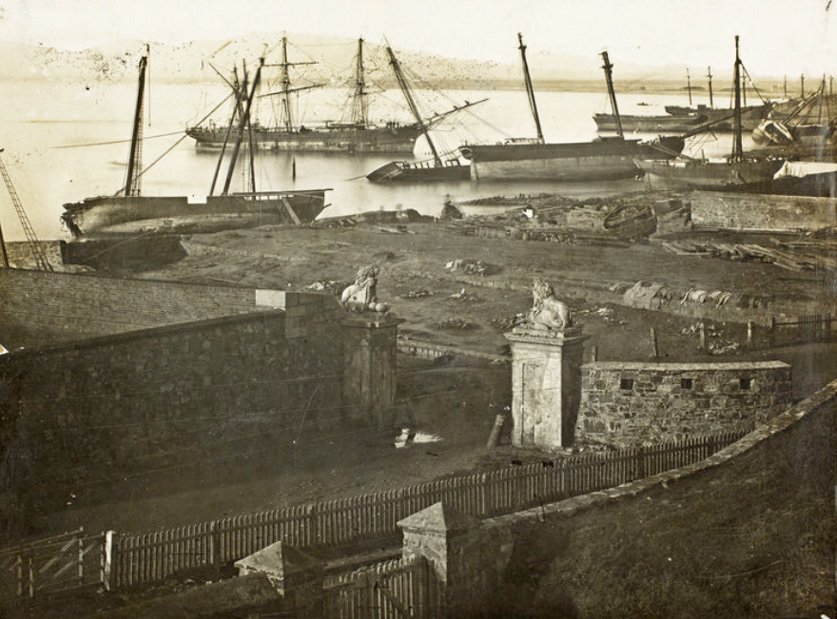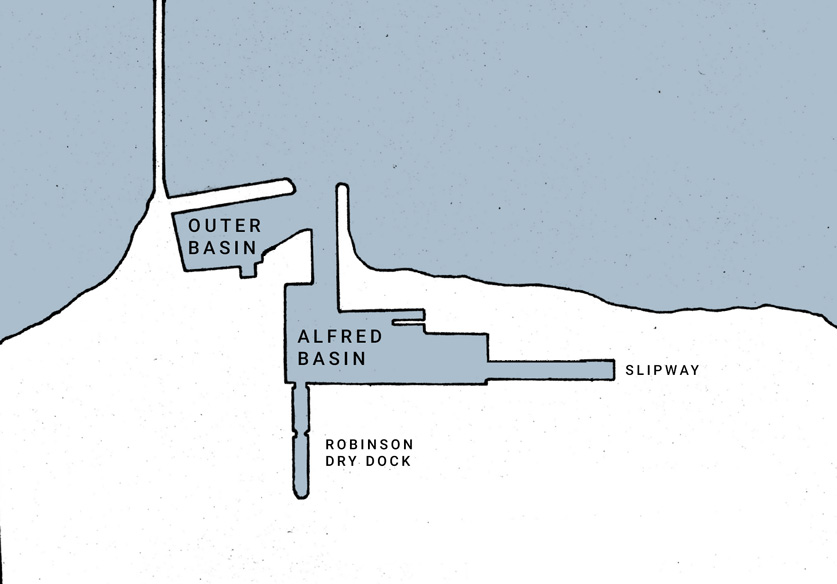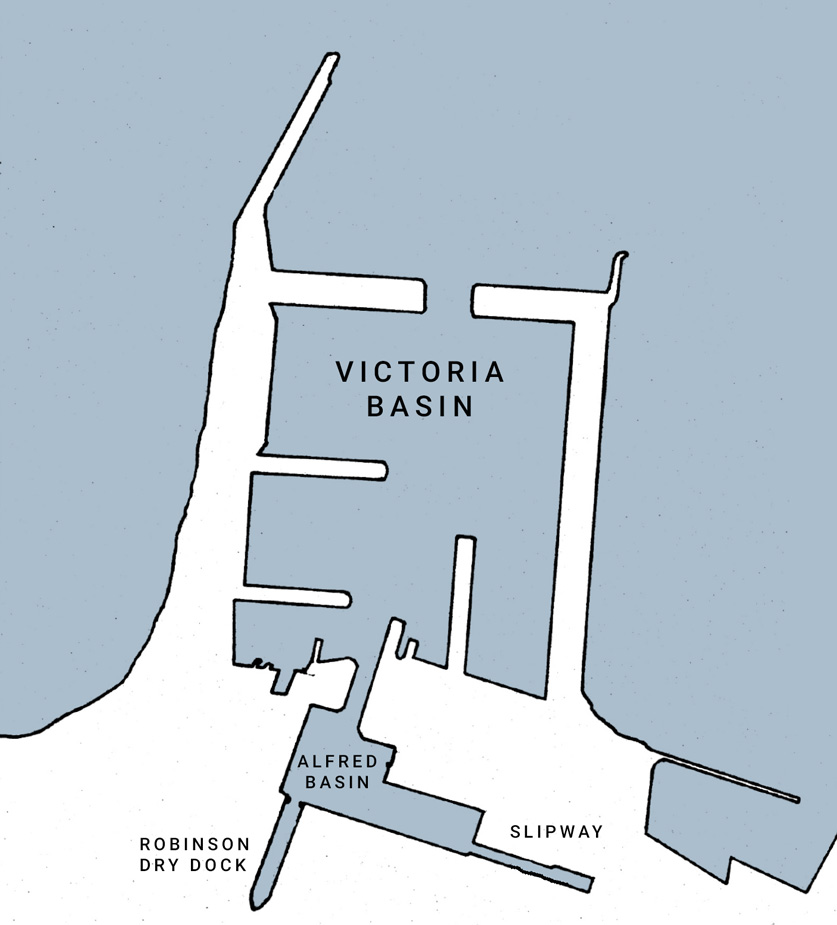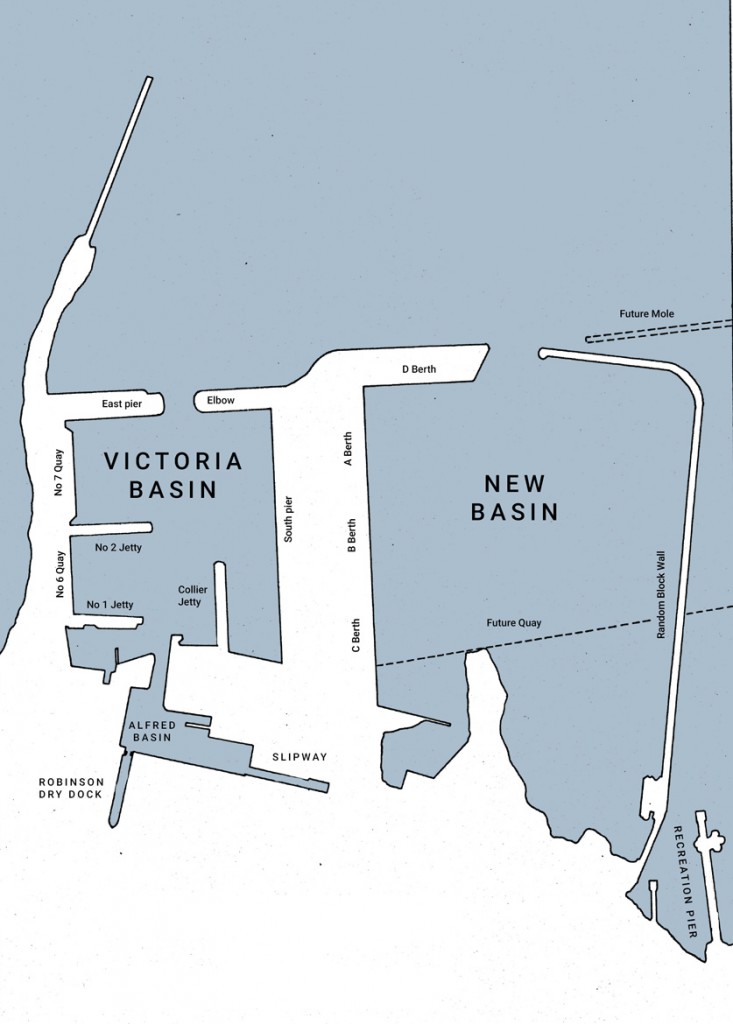After the successful rounding of the Cape by Portuguese fleets in 1487 (commanded by Batholomias Diaz) and 1497 (commanded by Vasco da Gama), several other fleets also came this way. Besides the Portuguese, Dutch and British fleets also came to the Cape, but, in 1652, the Dutch were the first to develop a settlement at the Cape. Although they did not intend to establish a permanent colony at the Cape, they built a growing settlement, largely to supply passing ships with fresh food, grain and water. (You will see small wooden jetties on each of the maps below for 1665 and 1767 – during the Dutch occupation – and 1854, by which time the British had taken control of the Cape.)

The Cape in c.1665 – note the wooden jetty that was used to bring cargoes and passengers ashore from ships anchored in Table Bay. Water in wooden barrels was taken out to the ships at anchor, as shown in the boat in the centre of the painting. In the background is the first fort that was later destroyed during a storm, and replaced by the fort that is now known as the Castle. Painting by Peter Bilas

The Cape in 1767 – note the position of the Fort (now known as the Castle), the star-shaped structure next to the beach. Redrawn from a map in the Cape Archives, after W.J. & A.M. Talbot
To prevent the Cape from being taken over the French with whom the British were at war and at the wish of the Dutch Prince Willem of Oranje, British forces captured the Cape from the Dutch in 1795. Once the French war was over and the French emperor Napoleon captured, the British returned the Cape to the Dutch in 1803.
When Napoleon escaped from the island where he was being held, and war resumed between the British and French three years later, the British retook the Cape from the Dutch during a skirmish called the Battle of Blaauwberg. The Cape then became a formal British colony under the control of a British Governor.
Despite a number of shipwrecks in Table Bay, especially during the winter when strong north-west and westerly winds and swells drove ships ashore, the only facilities for cargo and passengers were three wooden jetties.

The Cape in 1854 – note the three jetties. Redrawn from a map in the Cape Archives, after W.J. & A.M. Talbot
A harbour was designed with a breakwater to protect it from the prevailing swell. Construction work began in 1860, and much of the harbour was dug out of rock, with the breakwater constructed from the dug-out rock. While the harbour was still being built, a severe storm in Table Bay drove 18 ships ashore in one night!

The aftermath of the storm of 17 May 1865 with ships ashore near the Castle. Photograph : Library of Parliament
Two important events occurred during the construction of the harbour. The discovery of diamonds in the interior in 1867 led to the “diamond rush” that drew people from all over the world, but mainly from Britain. This in turn led to a large number of ships coming to the Cape, bringing passengers, mining equipment and household items for the fortune seekers. It led to the town of Kimberley being established in what today is known as the Northern Cape.
The Suez Canal was opened in November 1869, leading to most transit ships (i.e. those steaming between Europe and Asia or Europe and Australia) leaving the Cape route in favour of the new route via the Suez Canal. Although this was a loss of shipping to the Cape, the diamond rush made up for it as vast numbers of people continued to arrive at the Cape to travel overland to the Kimberley area.
The harbour (as shown below) that included the Alfred Basin (named after Prince Alfred who had tipped the first load of stones to start the breakwater construction in 1860), the breakwater, a drydock and slipway for ship repair were completed in 1870.
As increasing numbers of ships arrived in Cape Town, the harbour became too small, and had to be extended towards the sea. Over the next few years, the Victoria Basin was constructed, giving ten more berths for ships.

Cape Town Harbour 1898, showing the extension seaward that became known as the Victoria Basin. Photograph : Library of Parliament
The extension to the harbour gave more berthing space for ships, but two factors meant that further extension was necessary : larger ships were entering services to South Africa, making the Victoria Basin too small, and trade increased (especially after the economic slump of 1929), bringing more ships to Cape Town.
The harbour authorities decided to extend the harbour along the coast and created a new basin, with a “random mole” (a loose collection of concrete blocks and rubble) to enclose the harbour area.

Cape Town Harbour in 1937. Note the progressive growth from the Alfred Basin (just to the left of the tanks shown on the right of the photograph), the Victoria Basin and the New Basin where the dredger emitting a lot of smoke is seen. Note also the area that is being filled in (white area), and the random mole that is nearing completion. Photograph : Brian Ingpen/George Young Collection
Because of the large groups of ships (called convoys) that called at Cape Town during World War 2, the New Basin was extended urgently and completed in 1945. The new harbour construction project (later named Duncan Dock) included the filling in (reclamation) of large areas that formerly were water to become Cape Town’s Foreshore area that now has some of the city’s tallest buildings.
The new harbour basin had berths E to M, the Eastern Mole and it also had a drydock (Sturrock Drydock) that could accommodate the world’s largest ships at the time.

Cape Town Harbour in 1946. Note the berths E to M, the Eastern Mole and the Sturrock Drydock. Redrawn after SAR&H Annual Report 1946-1947

Cape Town Harbour in 1962. Note the Tanker Basin (for the import of crude oil for the newly-built oil refinery near Cape Town) and a Lay-up Basin (now known as the Elliot Basin) for the maintenance of small vessels. The Landing Wall (for bunkering and for easier entry for ships to the Sturrock Drydock) and the Repair Quay (for ship repair and maintenance) have also been added. Note also the progressive growth of the harbour from the Alfred Basin (the original harbour, completed in 1870), through the Victoria Basin (completed in 1917) to the Duncan Dock (completed in 1945) to the Tanker Basin (completed in 1962). Redrawn after SAR&H Annual Report 1962-1963
The next development was the preparation for containerisation that began officially on 1 July 1977. Not only was a large area required to stack containers before loading onto ships and after landing from ships, but the ships would be longer and have a deeper draught than any other cargoship on the regular trade to South Africa. A new container terminal was built and commissioned in 1977.

Cape Town Harbour in 1976. When this photograph was taken, the container terminal (the flat white and grey area in the foreground) was still under construction; the large gantry cranes to load and discharge the containers were installed during the following year. Note the growth in the harbour – Alfred Basin, Victoria Basin, Duncan Dock, Tanker Basin and the Container Basin. Photograph : Brian Ingpen/George Young Collection
In 2007, the Container Terminal was upgraded which involved extending and strengthening the concrete surface to allow containers to be stacked higher and therefore increasing the number of containers that can be stacked in the terminal. The Container Basin had to be dredged to enable deeper-draughted ships to berth, and eight new gantry cranes have also been installed to speed up container handling.

A dredger working in Cape Town’s Container Basin in 2009 to deepen it to allow deep-draughted containerships to berth.
A summary of events
A number of exceptional events have affected the number of ships calling at Cape Town, and at other South African ports.
- 1867 Diamonds were discovered near the present site of Kimberley. However, only after the sale of the Star of South Africa in 1869 was the economic significance of the diamond fields realised. The subsequent diamond rush brought thousands of immigrants, and created such an insatiable demand for mining equipment and supplies from Europe, particularly from Britain, that an unprecedented number of ships began to arrive in Table Bay and Algoa Bay.
- 1869 The Suez Canal was opened on 16 November, attracting most of the ships moving between Europe and the East, including those on the Australasian trade. (Although the number of transit ships calling at the Cape was reduced, the influx of people and the growting need for various imported goods to support diamond rush continued to bring ships to the Cape.)
- 1886 The discovery of gold in the Eastern Transvaal (now Mpumalanga) brought similar maritime repercussions as the discovery of diamonds. Because of its proximity to the Transvaal, Port Natal (now Durban) took much of the additional shipping. (In the long term, the discovery of gold brought an even greater economic boom to South Africa than the discovery of diamonds. This benefited shipping lines which were able to bring to South Africa great numbers of immigrants as well as a vast tonnage of mining equipment, consumer goods, appliances and stores.)
- 1899 The Second Anglo-Boer War began in October, bringing large numbers of troopships and military transports to the Cape and Durban. (After armistice in 1901, the country required significant development that led to an expansion of European settlement and importation of goods, and expansion in shipping services.)
- 1901 The Anglo-Boer War ended in May. (Cape Town continued to suffer serious port congestion after the cessation of hostilities because, while some British troops and equipment were being withdrawn, British control over the entire South Africa meant that more infrastructure and administrative capacity had to be developed, while the mining and industrial sectors began to grow steadily. This led to the growth of imports and exports, and the subsequent expansion of shipping services.)
- 1910 The unification of the Cape Colony, Orange Free State, Transvaal and Natal into the Union of South Africa allowed a single economic policy and stimulated economic confidence in the new country. Shipping services benefited directly from this as a new wave of immigrants arrived and trade increased.
- 1914 Britain and South Africa declared war on Germany on 4 August and World War 1 began. Shipping services were disrupted because of the conflict and because a number of important ships were taken over for wartime duties.
- 1918 World War 1 ended on 11 November, and shipping services began to return to normal. Large volumes of backlogged cargo and large numbers of troops and passengers were now able to be moved by sea, boosting global shipping.
- 1929 The Great Economic Depression began. Less cargo and fewer passengers meant that many shipping lines struggled to operate their usual services. By 1933, the global economy had returned to better times and shipping services reverted to normal.
- 1939 Britain declared war on Germany on 3 September, effectively beginning World War 2, and on 6 September, South Africa declared war on Germany. As the war progressed, shipping services became severely disrupted as ships were taken over for wartime duties, ships were sunk, and the focus was on the war, not on regular cargo and passenger services.
- 1945 The Second World War ends.
- 1946 Shipping begins to return to normal. Even more backlogged cargo, troops and passengers had to be moved by sea, than was the case after World War 1. However, the loss of many ships during the war created a shortage of ships so that freight rates and charter rates soared. Added to this was a demand for ships to move vast amounts of food, construction material, new machinery, and other resources needed for the rebuilding of Europe and Japan after the war. This generated a shipping boom, unparalleled until the boom from 2001 to 2007
- 1956 Owing to a war around the Suez Canal, the canal closed on 31 October, forcing thousands of ships to divert to the Cape route. South African ports suffered severe port congestion. (Of particular interest were the dozens of passenger liners that were among the diverted ships.) The canal reopened on 24 April 1957 and diverted ships returned to the canal route.
- 1967 The Six-Day War between Israel and Arab states began on 6 June, closing the Suez Canal, forcing thousands of ships to divert to the Cape Route. South African ports were severely congested. Because of the diversion of ships to the Cape route, radical changes in tanker and bulker design occur, and shipping operations changed.
- 1975 The Suez Canal reopen to shipping. As it has been deepened and widened, larger tankers were able to transit the canal, thus influencing tanker design and changing global tanker trade routes.
- 1976 Unrest in Soweto and the subsequent loss of life generated widespread anti-apartheid demonstrations. This and later protest action brought a new wave of trade sanctions against South Africa with a negative impact on shipping services to South Africa.
- 1990 On 2 February, President F. W. de Klerk announced the abolition of apartheid and also several political reforms that culminated in the release of Nelson Mandela from prison. This brought a wave of investment in South Africa and the start of a shipping boom. A week later, Nelson Mandela was released from prison.
- 1994 On 27 April, the first democratic election was held in South Africa; the local shipping boom gathered further momentum, bringing more ships to the country’s ports.
- 2002 In the wake of large-scale economic development in China, the shipping markets began a steep upward trend that became the largest shipping boom in history. (It lasted until 2007 when the “Credit Crunch” devastated the banking sector in USA and Europe, an economic slump occurred and a global shipping slump occurred.
- 2015 The South African economy declined. reducing cargo volumes moving through the ports, and reducing the number of ships calling.
Test Yourself
1. Cape Town harbour has developed from the first permanent settlement at the Cape.
1.2 What nationality were the first permanent settlers who later built a castle and developed a half-way station at the Cape?
1.3 Which nation controlled the Cape from 1806 until the Union of South Africa was formed in 1910?
1.4 The discovery of which mineral in 1886 brought large-scale immigration and led to a large number of ships calling at the Cape?
1.5 Which event in 1869 had a major negative impact in the number of ships calling at the Cape?
1.6 Fruit used to be exported in reefer ships. How is most South African fruit exported now?
1.7 Give one other reefer cargo that is exported from Cape Town?
2. A ship comes into Cape Town to bunker.
2.1. What does the term to bunker mean?
2.2. Why is it important to encourage as many ships as possible to bunker in Cape Town?
2.3. What can be done to attract more ships to bunker in Cape Town?
3. What was the effect of the first democratic elections in 1994 on shipping in South African harbours?
4. Although Cape Town’s Sturrock Drydock is the largest in Africa and in the southern hemisphere, why is the construction of an even larger and wider drydock essential?









